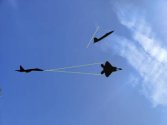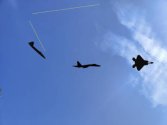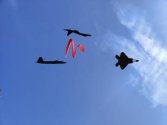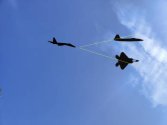Arguably the greatest example of what a modern peer air war would look like is the PAF-IAF clash earlier this year, and despite the engagement only lasting for less than a night, it was fairly tactically decisive. The major reason it wasn't operationally or strategically decisive is because neither side had the fleet size and the will/rationale to continue putting their aircraft in harm's way of the other side's aircraft, arguably because the initial round of losses was too devastating.
It was indecisive as heck.
One side tried to be tactical and decisive, flew flying colours into WEZ. Got bloodied, and went into safe mode for the rest of the conflict, throwing absolutely safe weapons from deep interior. First day, as much a spectacle it was, accounted for ~1% of Indian air TAF even per most optimistic claims.
After that engagenemt, no one was shot down for the rest of the war...
But for a true high intensity conflict where each side wants to gain air superiority and have the resolve and fleet size to push into theater, I expect true large scale peer air war will be devastating and decisive, and the outcome will be determined by the ability to generate high quality sorties capable of out BVR-ing the other side (as the most desirable set of traits inclusive of weapons, sensors, networking, stealth, sufficient kinematics to leverage BVR) en masse, which will prove the highest yield force.
I may be relying too much on WW2 maritime history as example, but rule of thumb is that for all the decisive preparations, rarely sides truly risked attritable assets (and when they did, more often than not it didn't really end well).
Occasional blood noses for expensive units, and most of war fighting done by attritable/disposable assets.
Because, even for 2 largest modern forces, which both stand at sub 2000 fleet(and production at below 200 mark, i.e. 2 aircraft per 3 days; lower rate for fighter pilots), throwing aircraftat a peer enemy isn't exactly acceptable.
To compare, for WW2, loss rates of couple of thousand aircraft per month and comparable number of crews was like...norm (and even that broke down Luftwaffe and japanese services).
Russia lost several dozen aircraft during spring 22(iirc something around 1 aircraft/day, which is a
highly optimistic assumption v US/China), i.e. 1 year of its a/c production in theory(~60 for modern Russia). In practice, much more, because losses weren't spread evenly, and even after campaign switched into indecisive archery phase, additional losses continued.
You are not describing a modern peer air war, you are describing defensive anti-cruise missile CAP.
Instead, think about an air war where each side has hundreds of 5th gen and 4.5th gen fighters contesting a theater of airspace supported by plentiful AEW&C, EW, and in the near future, CCAs and UADFs, where high end BVR and highly networked air to air engagements is not exceptional but rather the baseline ticket for entry to begin with.
I am merely describing majority of actual engagements of last ~2 years. Which are emerging more and more urgent, as these "cruise missiles" collect spectral intel, engage targets of opportunity through AI, mesh/satellite datalinks, drop drones and supplies for sabotage teams...
It's super dangerous to split "lowly" and "knightly" air defense, because at current point "low altitude air economy" simply creates another layer of air superiority, detached from the upper one. Which really questions value of singular focus on upper layer of air dominance - what good is it on its own?
Assuming both sides use effective means of forming airspace picture and weapons - that's exactly where indecisiveness comes from. Especially since defender, usually, has basic WEZ advantage.
Decisive action can come either when (1)side are determined that intensive, risky campaign will be more beneficial to them than to the enemy, and(1.1) it actually turns out this way, and (1.2)enemy can't disengage(which land air force in a big war almost always can). Or (2)when weapons used by one of sides are actually ineffective.
Basic assumption for peer conflict is that they're effective, or effective enough.
I.e.,
plentiful AEW&C, EW, and in the near future, CCAs and UADFs, where high end BVR and highly networked air to air engagements
I think when both sides keep to this level, it leads to a stalemate, not the other way around.
The way to achieve initiative is when there's a viable path to make opponent blind, or his weapons - ineffective. If sides are peers...risktaker just loses.




